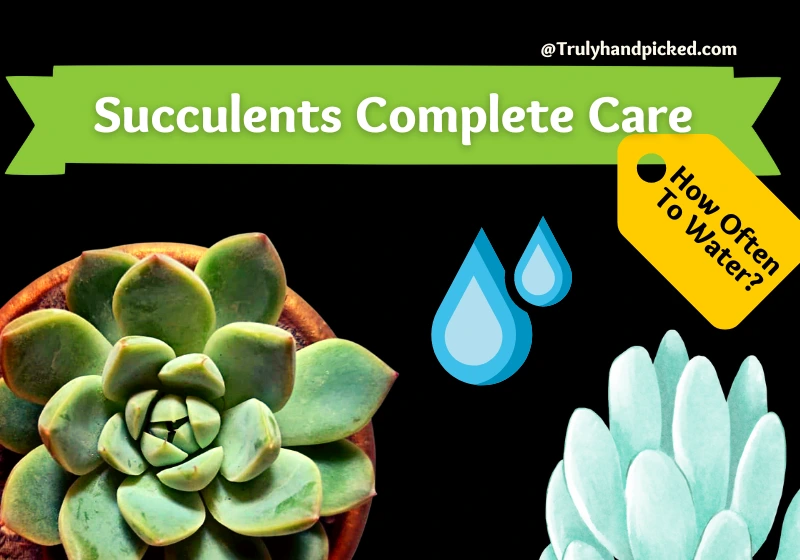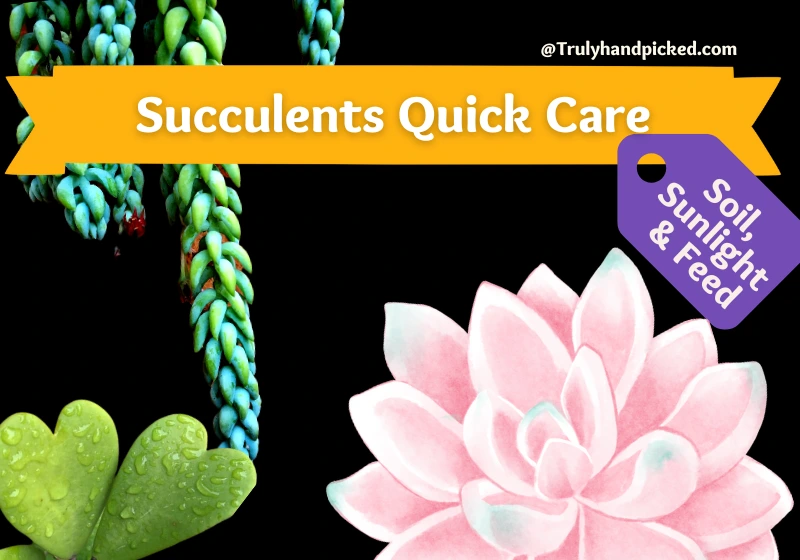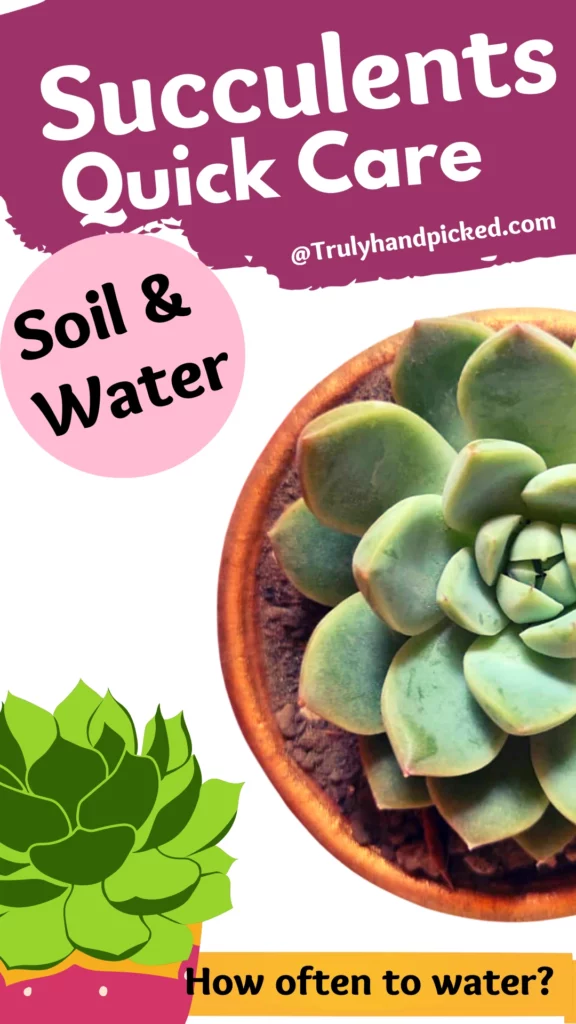Succulents are one of the favorites for the majority of plant-lovers who choose to grow them as their houseplants for low maintenance and appearance.
Succulents store water by themself and they are drought-tolerant by nature, but they do need water. While overwatering can kill your succulents, so be precise and stick to a watering schedule aligned with the season.
Watering: Water your succulents when potting soil turns totally dry and prefer clean filtered water or distilled or rainwater, rather than chemical tap water.
In a few cities, tap water from general sources may contain chlorine and fluoride, which may hinder your plant’s growth and health.
Avoid Misting your succulents it can result in mold and rotting. Even you can choose bottom watering by placing it in a small tub to plan with water to absorb from the bottom.
Despite their super classy looks, succulents are easy to cultivate and maintain, rather than other big foliage houseplants. If you are not very fond of flowering houseplants and like the view of ornamental plants, succulents are the best option to pick.
Here are some basic caring guidelines you must know before picking a succulent as bonsai for your indoor garden-
How Often to Water Succulents?
The only rule of watering your succulent is that the potting soil must be dried up entirely before the next watering. Some of the must-follow tricks of watering succulents are-
- Most succulents need two to three times a week watering, especially during the scorching summer days
- In winter, you can reduce the process to once every 7-day
- For the rainy season, try to avoid water or do it once a month
- And you should be capable of increasing and diminishing the watering level depending on the growth rate of your succulent houseplant.
Using ice to water succulents: No please don’t, and it’s not just for succulents don’t use ice watering for any plant. Better go for clean filtered water at room temperature. You can use ice cubes in earthworm casting, there it may add some bonus points to wormcastings.
Some Other Tips to Grow Succulents Healthily:
- Put your indoor succulent planter near the sun in any east-facing window
- Change the spot and rotate your succulent plant, when you grow them indoors
- Keep the watering level and watering time changing according to the seasons
- Water your plant directly and thoroughly, once the soil turns dry completely
- Plant a succulent in a pot that has a better drainage system
- Feed your succulents with foods (cactus mix) depending on their particular species, and don’t go for all-purpose fertilizers
- Often check and use protection to keep your favorite plants away from the grasp of greedy bugs or pests consistently.
Benefits of Growing Succulents in Home?
Succulents or cactuses gradually became one of the most popular plant species, especially, for indoor gardens. Well, several advantages work behind this popularity! Some of the most excellent benefits of having a succulent as a houseplant are-
- Work as a natural air purifier by eliminating volatile organic compounds from the air
- Enhance the environment by absorbing toxic elements
- Improve the humidity level of your home
- Supremely easy to grow due to their hardiness and compatibility with any type of climate
- Help in treating several chronic health issues sore throat, dry cough, itchy skin, etc.
- Increase the oxygen level of your house without releasing carbon dioxide, unlike other plants
- Helps you relax and gets you close to nature in your comfort zone
- And few of them (like aloe vera) have medicinal properties which aid in solving plenty of health issues expertly.
Best Types of Succulents to Grow Indoors:
Almost every species of succulents are easy-to-grow and needs extremely low maintenance. However, some types of succulents are even considered more effortless to cultivate than the other equivalent species.
Here are the best choices from their entire genus, which can make a brilliant houseplant to enhance your home interior exotically-
- Burro’s tail
- Jade plant
- Aloe vera
- Panda plat
- Echeveria
- Agave
- Cactus
- Crown of thorns
- Stonecrop, etc.
How to Grow and Care Succulents:
Now let’s look into these growing essentials more elaborately-
How to Prepare Soil and Potting Mix:
Succulents need well-drained soil that never becomes soggy with water. So, choose sandy or loamy type soil mixed with potting mix.
Use vermiculite or perlite to make your soil better drainage quality. You can use your normal garden soil in a ¼ part ratio while preparing this potting soil at home.
Watering Needs:
Once you prepare the soil and plant the succulent into the planter properly, pat the top surface of the soil and water the plant thoroughly once, after 2-3 days of the plantation. Make sure the water is draining properly from the bottom. Check your plant every 7-10 days and water only when it seems dry and extremely necessary.
Fertilizer How and When to Feed:
Succulents prefer organic fertilizer over commercial fertilizer. Try any homemade plant food to feed your succulent houseplant perfectly.
Organic wormcast, manure tea, fish emulsion, Epsom salt, etc. are good ones to pick. You can even use any other balanced water-soluble fertilizer with a 10-10-10 ratio to feed such plants properly. Try to feed your succulents during the summer for the utmost time, as it is their chief growing season.
Lighting and Temperature:
Succulents can tolerate high temperatures ranging from 60 to 90 degrees F during their growing session. Make sure you provide your indoor succulents with at least 6-7 hours of direct sunlight every day. For garden succulents, you can provide some shades to provide filtered sunlight for 8-9 hours a day.
Succulents are turning brown: Intense heat waves, scorching sun, or sudden change of place may hinder your plant’s growth and turn the succulent leaves brown.
Troubleshoot and Solutions:
Most of the succulents face a few common troubleshooting during their thriving session. These are-
- Wrinkled or wilted upper leaves
- Brown patches on leaves
- Discolored leaves and
- Become leggy with elongated growth
Such issues mostly occur due to over or under-water problems. Sometimes, inadequate light supply or an infestation of pests initiate these difficulties for your loving succulent. To solve these issues, you must find the real cause behind the problem first and act accordingly.
How to Care Succulents: Quick Recap
Soil: Succulent plants need porous type soil with sandy and well-drained quality. Maintain the pH balance between 4 to 6.5 for any type of species.
Water: Succulent plants don’t need much water to thrive. Only water when the top surface of planting soil seems dry completely.
Fertilizer: You can use any organic fertilizer to feed your succulent houseplant from manure tea to fish emulsion, and from compost to kitchen scraps.
Sun Exposer: Succulents love full and direct sun exposure. Try to provide your plant with at least 6-7 hours of direct sunlight every day.
Hardiness Zones: Such plants are extremely hardy and can stand 5 to 6 hardiness zones.
How to Propagate Succulents:
You can grow succulents from their cutting easily with some simple propagating tips. To propagate or grow succulents, you must choose the leaves’ part or the stem cutting and cut it off with a sharp object. Now follow these steps accordingly-
- For the stem cutting, hold 2-3 inches part of the apex of a healthy stem and rip it off
- Prepare a planter with potting mix and perlite mixture, and sow that cutting carefully into it
- Don’t forget to wipe the dropping fluid part beneath the cutting before the replantation
- To pluck the leaves, separate a bunch of vigorous leaves from your succulent plant first
- Now, put the bunch of leaves in a glass container full of water, by dipping the end part steep into the water
- Let the container store in a cool shadowy place for a week and then, plant in a pot with permeable soil, once the root forms
- Make sure you feed your newly grown succulent and fulfill their water needs perfectly to get a successful outcome of your process.


